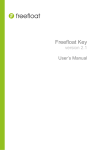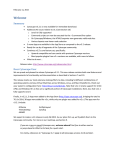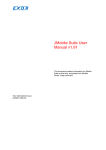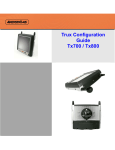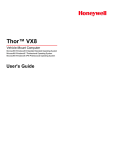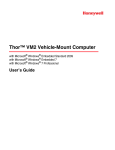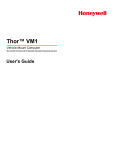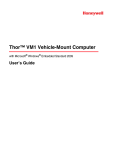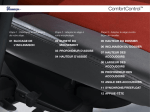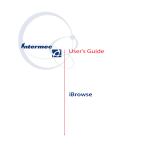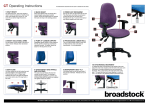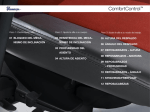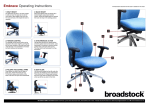Download FreeFloat Access Manual
Transcript
Freefloat Access version 2.5 User's Manual Contacting Freefloat .................................................................................................................................. 1 Introduction .................................................................................................................................................. 2 System Requirements ........................................................................................................................... 2 Supported Windows Devices............................................................................................................. 2 Terminal Emulation ............................................................................................................................... 3 Product Features .................................................................................................................................... 3 Emulator Features .................................................................................................................................. 4 5250 Features........................................................................................................................................... 5 Getting Started ............................................................................................................................................. 6 A Typical Installation ............................................................................................................................. 6 Step 1, testing the host connection from your PC ................................................................ 6 Step 2, configure and install on CE device ............................................................................... 6 Step 3, licensing the emulator ...................................................................................................... 7 The Emulator ...............................................................................................................................................10 Screen Layout ........................................................................................................................................10 Emulator Text Area .........................................................................................................................11 Keyboard.............................................................................................................................................12 Status Area .........................................................................................................................................13 The Splash Screen ...........................................................................................................................14 Splash Screen Mode .......................................................................................................................14 Locating the cursor, centering the screen around it ..............................................................15 Scrolling the screen without moving the cursor position (moving the viewport) ......15 Moving the cursor (insertion point) ..............................................................................................15 Scanner.....................................................................................................................................................16 Scanner On/Off Control in 3270/5250 emulation ...............................................................16 Scanner On/Off Control in ANSI emulation ...........................................................................16 Display Character Translation ..........................................................................................................17 Screen Modes.........................................................................................................................................19 Standard Mode ......................................................................................................................................19 Locked Mode..........................................................................................................................................19 Center Cursor Mode ............................................................................................................................19 Screen Cursor Mode ............................................................................................................................20 Corner Mode ..........................................................................................................................................20 Full screen Mode...................................................................................................................................20 VT/ANSI ....................................................................................................................................................21 Line Mode ...........................................................................................................................................21 Attribute Mapping ..........................................................................................................................22 Printing ................................................................................................................................................23 Logging ....................................................................................................................................................24 The Configuration Application ............................................................................................................25 The Screen Layout ................................................................................................................................25 Option Types ..........................................................................................................................................26 The CEInstaller Application ...................................................................................................................27 What is transferred during installation and where is it? ........................................................28 Keyboard Mapping ...................................................................................................................................29 How to map a key.................................................................................................................................29 Key Table .................................................................................................................................................30 Local Action Keys..................................................................................................................................34 Emulation Actions ................................................................................................................................35 Configurable Keyboard ...........................................................................................................................35 Scripting........................................................................................................................................................36 Overview ..................................................................................................................................................36 The Lua Language ................................................................................................................................37 Script Events ...........................................................................................................................................38 Event Methods ......................................................................................................................................39 onKey( keyname ) ............................................................................................................................39 onStart() ..............................................................................................................................................39 onEnd() ................................................................................................................................................40 onActivate() .......................................................................................................................................40 onDeactivate() ..................................................................................................................................40 onCursorMove() ...............................................................................................................................41 onEvent( eventname ) ...................................................................................................................41 onNetworkData() .............................................................................................................................41 onMouseClick() .................................................................................................................................42 onMouseWheel( delta, shift, control )......................................................................................42 Script Methods ......................................................................................................................................43 Output .................................................................................................................................................46 Text Buffer ..........................................................................................................................................52 Cursor ...................................................................................................................................................55 Scanner and Barcode .....................................................................................................................57 Viewport..............................................................................................................................................60 Emulation Type ................................................................................................................................67 Time & Timer Events .......................................................................................................................68 Session Control.................................................................................................................................75 Application Launch .........................................................................................................................78 Font .......................................................................................................................................................81 On-screen Keyboard Control ......................................................................................................85 Freefloat Link Integration .............................................................................................................94 Hotspots...................................................................................................................................................97 Appendix A – Model Specifics .........................................................................................................98 Casio DT-X7 ........................................................................................................................................98 Casio DT-X8 ..................................................................................................................................... 100 Denso BHT-400 .............................................................................................................................. 102 Symbol PPT8846 ........................................................................................................................... 102 Machines that have a sound device capable of playing wav-files ............................. 102 PSC Falcon 44xx with monochrome screen ....................................................................... 102 Appendix B – Logging Network Data ............................................................................................. 104 Appendix C – EBCDIC Character Tables ......................................................................................... 105 Code Page 278, Swedish/Finnish ................................................................................................ 105 Code Page 37, USA/Canada........................................................................................................... 106 Appendix D – TN5250 Auto-signon ................................................................................................ 107 Appendix E – TN5250 Enhancement Settings ............................................................................ 107 Appendix F – Command Line Parameters .................................................................................... 108 Appendix G – Version History ............................................................................................................ 109 Copyright © 2003–2012 Freefloat AB Contacting Freefloat Forum Web E-mail http://forum.freefloat.com/ http://www.freefloat.com/ mailto:[email protected] Page 1 Introduction Freefloat Access was developed to enable the many users of IBM mainframes and various *NIX and other ANSI/VT-compatible systems to seamlessly integrate these devices into their daily operations at a reasonable cost. The emulator supports VT52, VT100 and VT220, TN3270, and TN5250. Functions that can’t be supported on certain devices due to hardware limitations are either ignored or mapped as appropriate. System Requirements Note! The below requirements are for the PC, onto which the product is installed. The actual terminal emulator runs on the devices listed below. • • • • • Windows XP/2000/Vista Minimum 16 MB memory, (the Windows emulator takes max 3 MB of memory) The disk space required is displayed by the installation program Microsoft ActiveSync v3.5 or later (for installing on a CE device, version 3.5, 3.7, 3.7.1, and 3.8.0 has been tested) Adobe Acrobat Reader 4.05 or later Supported Windows Devices For a list of supported devices, please refer to the product page for Freefloat Access on www.freefloat.com. Page 2 Terminal Emulation • • • • • IBM 3278-2 (24 x 80 monochrome) IBM 3279-2 (24 x 80 color) IBM 5251-11 (24 x 80 monochrome) IBM 3179-2 (24 x 80 color) DEC VT52, VT100, VT220 Product Features • • • • • Configuration application Installation program for installing the emulator and configuration on Windows CE devices Freefloat Key integrated, configurable layouts via Freefloat Key Designer Full screen emulator for demonstration and testing purposes enabling you to test the configuration, scripts, etc. before deploying onto the CE device Host simulators for VT, 3270, and 5250 which enables you to test the emulator on the CE device without having access to a real host Page 3 Emulator Features • • • • • • • • • • • • • • • • • • • • • • NEW! The dynamic script language Lua has been embedded which makes Freefloat Access very powerful, flexible and extensible The ability to block the user from accessing the Windows CE shell Support for multi-session to the same or a different server with the same or different emulation type Variable font size, bold or normal Large user-configurable keyboard Solid or blinking cursor Hotspot support Color support in all emulations Fully customizable colors VT/ANSI attributes can be mapped to colors VT/ANSI big text (double width, double width/double height) Supported text attributes: Underline, Reverse, Intensify (Bold), Blink, Colors, Invisible, Column Separator (5250) Centering of the viewport on cursor and/or movement keys Manual or automatic centering of the viewport Viewport locking Fully customizable character translation between the host and the device Customizable key strings Real full-screen usage on CE device, even hides (optionally) the taskbar. Tight device integration (for example barcode reader, radio control, beeper & vibrator) Customizable mouse (touch screen) behavior A different kind of signal (beep and/or vibrator) controllable from the host VT/ANSI pass-through printing Page 4 5250 Features • • • • • Handles more than 256 fields on one screen correctly. Supports the 5250 Text Window definition with full attribute support, header, footer including attributes and orientation for header and footer. 100 % color and attribute support in both color and monochrome mode. Handles multi-line fields correctly, even fields that cover the entire screen. Full and correct field type/field properties support: Alphabetic Only (also accepts international letters according to IBM’s specifications) Alphabetic Shift (actually means all characters are allowed) Monocase (also uppercases international letters) Signed Numeric Numeric Only Bypass Field Exit Required Mandatory Entry Mandatory Fill Right Adjust Zero Fill Space Fill Dup Enable Numeric Shift (actually the same as Alphabetic Shift) Modified (the host can set the modified status of a field directly in a screen definition) Page 5 Getting Started Since you are reading this you have managed to install the product on a PC. A program group called Freefloat Access was created on your Start menu. The program group contains icons for configuring the various emulators (CE device specific ones and the one for regular Windows), the CEInstaller program which installs the emulator on a CE device as well as the configuration, support files, character mapping files, and optionally scripts. There is also an icon for starting the emulator on your PC. A Typical Installation Let's say you have a 3270 host. It's IP address is 192.168.1.3. It serves TN3270 connections on port 23. You also have a Denso CE device that you want to connect to the host. Step 1, testing the host connection from your PC 1. Select the icon Config Freefloat Access on the Start menu. 2. The configuration application is displayed, the configuration for the regular Windows version of the emulator is automatically opened. 3. In the configuration application, go to the option Common\Connection\Host. 4. Enter the IP address for your host (192.168.1.3). 5. Go to the option Common\Connection\Emulation Type 6. Select the emulation (TN3270 Color 24x80). 7. Choose File/Save to save the modified configuration. 8. Exit the configuration application. 9. Start Freefloat Access by selecting the icon Freefloat Access on the Start menu. 10. Make sure you can connect to your host. This must be done with a new CE device prior to installing the emulator on it: Start your CE device and configure your CE device's RF network card so it can associate with an access point. For example: SSID (network name), IP address (fixed or dynamic), WEP encryption keys or other encryption settings if applicable. Please see the documentation for the CE device on how to do this. Step 2, configure and install on CE device 1. Select the icon Config <manufacturer name>/<device name> depending on what CE device you are using. 2. Go to the Host option and enter your host's IP address. 3. Go to the option Emulation Type and select the desired emulation. Page 6 in the toolbar of the configuration application. 4. Save the configuration and click on This will start the CEInstaller application. It installs the emulator on the CE device. 5. Start the CE device and make sure it is synchronized with your PC via Microsoft ActiveSync. 6. Click on the Install button. 7. After the emulator is installed, start it and check that the emulator connects to your host. Step 3, licensing the emulator When the emulator is started on the CE device for the first time it is unlicensed. The following dialog box is displayed: To license the emulator, write down the MAC address, contact your reseller or Freefloat to buy a license. You will then receive a license key. Until you have received the license key, you can run the emulator in demonstration mode. The demonstration mode has no limitations except that it times out and exits after 20 minutes. Page 7 When you receive the license key, click on the Register button in the dialog box above. The Register dialog box will be displayed: Enter the digits from the license key into the boxes. Leave out the hyphens (-). If the license key you received was 111111-222222-333333-444444 your dialog should look like this: Click on the Register button to complete the registration process. Page 8 If you made a mistake when entering the license key, you will get the following message when you click the register button: When you click the OK button you will be taken back to the Register dialog box. Page 9 The Emulator This topic explains the different screen objects present in the emulator. Please note that the window size of a CE device can be simulated in the regular Windows version of the emulator by setting the Win32\Window Size option to Quarter VGA. Screen Layout Here's how the emulator might look like on a Quarter VGA color device: Page 10 Emulator Text Area The emulator text area is the area above the status area. Data from the host is in this area. Please note that the keyboard covers the text area when visible. When you touch or click on the emulator text area the action depends on the onMouseClick event in the script. Page 11 Keyboard The keyboard is displayed below the emulator text area: There are canvases for characters (even international ones), function keys, movement keys, and some special control buttons. If you click on the canvas background, i.e. not on a button, you can drag the canvas to a new position. Use to select another canvas. will end the host session. increases and decreases the font size used in the emulator text area. Note! Changes to the font size is not saved to the configuration file. To make permanent changes to any option you need to use the configuration application and then transfer the new configuration file to the CE device. displays the version of the emulator. Page 12 Status Area • is the radio connection indicator. This indicator only works on Denso and Motorola/Symbol handhelds (and some other models), on other machines it displays as ( ). If the flash disappears ( ) the CE device has lost its connection with the Access Point. this area displays the current emulation, ANSI, 3270 or 5250. In VT/ANSI emulation this text can be _ANSI, LANSI or lANSI. If a space, the emulator is not in linemode, if L the emulator is in negotiated linemode, if l (lowercase L) it is forced local linemode. Clicking on the Popup Area toggles the keyboard. is the 3270/5250 operator error indicator. A or N You tried to enter text outside a field You tried to enter invalid characters into a numeric only field You tried to enter more data into a field than there is room for The emulator is waiting for a host response Data has been received from the host and is being processed Insert mode indicator Input Mode indicator (only active on some models) Tells you whether the input mode is alpha or numeric. On a Denso BHT-200 you press the ALP key to toggle. , If the keyboard is locked, indicated by Keyboard Reset Area to unlock the keyboard. , and , you can click on the is the battery level. is the cursor location indicator. To quickly locate the current cursor position (the active input), click on the Find Cursor Area. Page 13 The Splash Screen When the connection to the host is terminated the Splash screen is displayed. When the option Forced Mode Password has been given a value, a dialog box will appear. To be able to exit the emulator, the correct password must be entered. The Splash screen is also used for displaying network error messages. Here’s how the Splash screen might look like: Splash Screen Mode There are two different splash screen modes, the normal one with Re-connect and Exit buttons and a more specialized mode where the Reboot button has been made very large and centered at the bottom of the splash screen. In this specialized mode there is also a Reboot button which reboots Windows. The Reboot mode for the splash screen is only useable in Windows 2000/XP, not in Windows CE. Also it need VGA resolution or higher. The option that controls the splash screen mode is: Common\Screen\Splash Screen Mode Page 14 Please note that the following three functions will NOT move the viewport when the screen has been locked with the script command app.lockWindow(). Locating the cursor, centering the screen around it Due to the tiny screen of most CE devices, it is very easy to loose track of the cursor position. To quickly locate the current cursor position (the active input), the following shortcut method can be used. Touch or click on the Find Cursor Area. The emulator will try to center the viewport around the cursor, so the operator can see as much as possible of the screen at that position. This doesn’t move the cursor, but moves the viewport to the cursor position. Scrolling the screen without moving the cursor position (moving the viewport) Push and drag in the emulator text area. Please note that the scrolling can be disabled by the script. If you need viewport scrolling from the Freefloat Key keyboard, define four keys that send Alt+arrow keys. Moving the cursor (insertion point) If the option Center On Arrows is enabled, the emulator will try to center the screen around the cursor, so the operator can see as much as possible of the screen at that position. This moves both the cursor and the viewport to the new cursor position. If the option Center On Arrows is disabled, only the cursor moves, so if the cursor moves off the visible screen, the operator must use the function Locating the cursor, centering the screen around it described above, to locate the cursor. On the keyboard canvas with arrow keys, use the arrow keys to move the cursor to the screen position desired. If the CE device has hardware cursor keys, they can also be used to move the cursor. Page 15 Scanner This section only applies to models where Freefloat Access has direct control of the barcode device You can disable the option Barcode Reader if you are using a third-party barcode wedge software. If the option Barcode Reader is disabled, the barcode parameters will have no effect. All scanned data is internally converted to keystrokes, so any data scanned can also be input from the keyboard. Please note that you may customize what happens when a barcode is read by modifying the script code for the event onBarcode. Scanner On/Off Control in 3270/5250 emulation By default, Freefloat Access turns off the scanner when the cursor is outside any input field or when there are no input fields on the screen. But if for example you need to simulate AID keys (function keys) by reading a barcode, the scanner needs to be enabled at all times by enabling the parameter Common\Barcode\Barcode Reader Always On. Scanner On/Off Control in ANSI emulation CSI % 0 S disables the scanner. CSI % 1 S enables the scanner. Page 16 Display Character Translation General Description As delivered, the emulator is configured for the Swedish character set in 3270 or 5250 mode (Codepage 278), and in ANSI mode it uses the DEC Multinational character set (ISO/IEC 8859-1 Latin 1). ANSI Mode ANSI characters from the wire are converted to Unicode using the ansi2uni.map table before being stored in the screen buffer for subsequent display. Characters entered via keyboard are translated using the uni2ansi.map table before they are put on the wire. 3270 or 5250 Mode Input from the keyboard is converted to EBCDIC using the uni2ebc.map table before being put into the buffer. All characters in the buffer (whether they came from the host or from the keyboard) are converted from EBCDIC to Unicode using the ebc2uni.map table before being displayed on the screen. You can change the default character mapping via one of the four mapping files: Filename Mapping function uni2ebc.map Unicode (from keyboard) to EBCDIC (in buffer) mapping. ebc2uni.map EBCDIC (in buffer) to Unicode (screen) mapping. uni2ansi.map Unicode to ANSI (VT220 Multinational) mapping. ansi2uni.map ANSI (VT220 Multinational) to Unicode mapping. If any of these files exist, it will be used to change the default character mapping for the characters defined in that file. Only the characters defined in that file are changed from it’s default mapping. Sample contents of ansi2uni.map: // // // // // ANSI2UNI translates from network ISO11 Swedish (7-bit ASCII) to screen Unicode ISO11 Swedish value arrived from the wire, Unicode value to display on screen 0x60,0xe9 0x7b,0xe4 0x7c,0xf6 0x7d,0xe5 0x7e,0xfc 0x5b,0xc4 0x5c,0xd6 0x5d,0xc5 0x40,0xc9 0x5e,0xdc Page 17 The corresponding file uni2ansi.map would normally reverse this mapping as shown below: // UNI2ANSI translate from keyboard Unicode to network ISO11 Swedish // // Unicode value arrived from the keyboard, ISO11 Swedish value // to send to host 0xe9,0x60 0xe4,0x7b 0xf6,0x7c 0xe5,0x7d 0xfc,0x7e 0xc4,0x5b 0xd6,0x5c 0xc5,0x5d 0xc9,0x40 0xdc,0x5e Page 18 Screen Modes The screen modes govern which portion of the larger terminal screen the emulator initially displays and how this viewport moves as the cursor moves. Standard Mode This is the default mode and it begins with the window in the upper left corner of the larger terminal. The user is free to move the viewport, either automatically as defined by the options Center On Arrows, Center On Tab and Center On Backspace, or by the two functions Locating the cursor, centering the screen around it Or Scrolling the screen without moving the cursor position (moving the viewport) Locked Mode In locked mode the viewport is locked to the coordinates defined by the script command app.setOrigin(). The default position is the upper left-hand corner of the display. The viewport does not move around, and only the selected window area is visible. Locked mode disables the windowing keys (arrow keys, tab, backtab and backspace) and only allows you to window around the physical display by the script command app.setOrigin(). Center Cursor Mode Center cursor mode works best for applications that use the entire 80-character by 24-line logical display. In this mode, the cursor remains in the center of the terminal’s screen if possible. As the cursor moves within the logical display, the emulator’s viewport window moves to keep the cursor as centered as possible, showing as much as possible of the logical display on all sides of the cursor position. Page 19 Screen Cursor Mode Screen center cursor mode ensures that the cursor is always visible. As the cursor moves within the logical display, the emulator’s viewport window moves in increments of the viewport window’s width and height. If, for example, the viewport can display 12 lines with 20 characters wide the screen will effectively be divided into 4x2 screen parts. The first part will contain column 1 to 20 of lines 1 to 12 and the last part will contain column 61 to 80 of lines 13 to 24. When the cursor is moved (either by user or host) into one of these parts, the viewport will snap into the part. To enable this mode set the parameter Follow Cursor to the value Screen. Corner Mode Corner mode begins with the window in the upper left corner of the larger terminal. It tries to keep the cursor in the lower right corner of the display, showing as much as possible of the logical display above and to the left of the cursor position. Corner mode works best for applications that use the upper left corner of the logical screen. As the cursor moves off the right or bottom edge of the radio terminal’s display, the window moves to show the cursor. The distance moved and when movement should occur is determined by the options Row Offset and Column Offset. Full screen Mode Regular Windows version only. This mode use the entire screen, hides the taskbar. Keys that bring up the Start menu or switch to other application are filtered, making it impossible to switch away from the emulator to any other program. Page 20 VT/ANSI Line Mode Do not activate this parameter for 3270 or 5250 emulation. 3270 and 5250 are both blockdevices, where the whole screen is one big “line mode” and only transmits when Enter or a PFkey is pressed. To activate ANSI Line mode, enable the option Force Line Mode. In the default “character-at-a-time” mode, (also known as full duplex) every key press or character scanned from a barcode generates a network packet transmission to the host. The host then echoes the character back to the handheld, possibly pre-pending it with cursor positioning escape sequences and then the handheld displays the character on the screen. So, for every character pressed or scanned, the handheld generates one radio transmission and receives one or more packet(s). For example, if we scan a 20-character barcode, the handheld will generate 20 packet transmissions, and receive at least 20 packets. When the radio is active, the power consumption of the handheld is much higher, up to five times the normal consumption, so it is easy to see that if we can reduce the transmissions, the battery will last much longer. Line mode will do just that. As long as we remain on the current line, and the cursor position is to the right of the first input position, and no key is pressed that would move us away from the current line, (arrow keys, Page Up/Down, Enter or backspace beyond the first input position), every key pressed or character scanned is buffered in the handheld. When a key is pressed that requires the collected data to be transmitted, all data is then sent as ONE packet. Using the previous example, our 20 packet transmissions and receptions are reduced to one transmission, and usually also to one reception, a reduction by 20 times! Naturally, the battery now lasts much longer. Not all applications work correctly in linemode, but the majority can benefit from this option. Since all echoing of characters are done locally, password entries will be visible, because the handheld always echoes, and has no knowledge about the contents format. Page 21 However, this can be beneficial, since it is very easy to enter the wrong key using the sometimes awkward keyboards present on some handheld’s, but the tiny screen usually prevents anyone else but the operator to read what was entered. Attribute Mapping In VT/ANSI emulation, the attributes bold, reverse, underline, and blink can be mapped to a text color. For example, to map the attribute bold to red, enable the parameter VT/ANSI Emulation\Attribute Mapping\Map Bold, and then make sure VT/ANSI Emulation\Attribute Mapping\Bold Color is set to red. Mapped attributes have priorities in the order bold, reverse, underline, and blink. This means that if some text is both bold and underline and bold is mapped to red and underline to blue the text will be red because bold has higher priority than underline. Page 22 Printing Supported modes are: Page print Prints all information currently displayed on terminal screen. ESC[0i Octal 033 133 060 151 Decimal 027 091 048 105 Hex 1B 5B 30 69 Controller print Print is passed through the terminal and displayed only on the printer. The terminal will pass all codes except the print on and off commands to the printer. The terminal will not interact with the operating system during print. Print on: Octal ESC[5i 033 133 065 151 Decimal 027 091 053 105 Hex 1B 5B 35 69 Any data received after Print on is directed to the printer instead of to the screen. Print off: Octal ESC[4i 033 133 064 151 Decimal 027 091 052 105 Hex 1B 5B 34 69 Configuration Settings The setting Port Name can be any valid output device, the most common ones are LPTx: or COMx: . If the port selected is a serial COM port, you must specify at least Baud, Parity, Data and Stop. The settings Port Settings consist of the following (where each parameter is separated from the next by a blank/space): Baud=n where n is any valid numeric baudrate. Parity=p where p is N for None, O for Odd or E for Even parity. Data= n where n is 5, 6, 7 or 8 databits. Stop= n where n is 1 or 2. Optional parameters are (default value if not specified shown as bold): to=on/off If on, printing will be aborted if no data could be printed for 60 seconds. xon=on/off Software handshake using the XON/XOFF protocol. octs=on/off Hardware handshake using the CTS line. odsr=on/off Hardware handshake using the DSR line. dtr=on/off Sets the DTR line (output) on/off. rts=on/off Sets the RTS line (output) on/off. rts=tg RTS is on only then transmitting. Page 23 Logging The emulator maintains a log file where information about certain event(s) and error conditions are registered. The start time and emulator version are always registered each time the emulator starts. The log file is trimmed to the last 100 lines. The name of log file is LOG.TXT and it’s located in the root of the file system of the CE device. When running Freefloat Access on regular Windows, the log file is placed in same directory as the executable. Page 24 The Configuration Application Use the Configuration Application to configure the emulator to your preferences. The emulator will only load it's settings from a configuration file called Terminal.cfg. The Screen Layout In the left window pane you select the option you want to change or inspect. When you click on an option the option's value is displayed in the right window pane together with a description of the option. Page 25 Option Types Type Toggle Description An option that can be enabled or disabled. Word An option that holds an integer value. It also has a minimum and a maximum. If an invalid value is entered, a message will tell you that, together with the allowed range of values. An option that holds a text value. String List An option for which you can choose from a list of values. Color A color option. Click on the button to select a color from the color palette dialog box. Color Pair A color option that sets both foreground and background colors. There is also an area that display a sample with your color selection. Page 26 Sample The CEInstaller Application CEInstaller is started when you click the install button . It transfers the configuration, the emulator, some support files, and any scripts you might have written onto the CE device. Above you see a typical installation. CEInstaller connects to the CE device through ActiveSync. If you already have installed the emulator and just wants to download a new configuration, select Configuration in the Files listbox. Page 27 During the installation process the application folder is created and files are transferred. If the emulator has been previously installed and is running on the device, you get the error message Failed to create file ... on CE device. Maybe the emulator is running?. Exit the emulator on the device and retry the installation. If the problem persists, reboot the CE device, preferably with a hardware reset button. The emulator is installed in Flash memory (on selected devices). Even if the unit runs out of batteries or is cold-booted you don't need to re-install the emulator. You might have to reconfigure the RF card though. What is transferred during installation and where is it? The CEInstaller installs the files from the directory on your PC that corresponds to the machine selected in the Configuration Application. For example, the files installed to a Denso BHT-200 are located in C:\Freefloat\Freefloat Access xxx\Denso\BHT200 xxx above reflect the version number of Freefloat Access. As an example, let's add a script to the folder for the BHT-200. 1. Start Notepad. 2. Enter the following text: function myTestFunction() app.send( "Hello there!" ) end 3. Save it as Test.lua in the folder C:\Freefloat\Freefloat Access xxx\Denso\BHT200. (The path might be different depending on where you installed the product on your PC.) 4. Start CEInstaller and select Scripts in the listbox Files. Then click on the Install button. 5. As you can see the script file you just created is transferred to the CE device. Page 28 Keyboard Mapping Key mappings are defined in the script file keytables.lua. It contains a table for VT/ANSI keys (keyTableAnsi) and a table for 5250 and 3270 emulation (keyTable5250). If line mode buffering is used in VT/ANSI, please note that all characters generated from a key mapping are not sent directly to host. Append {flush} to send the characters in the key mapping directly to the host. For example: ["KEYF5"]= "\027OT{flush}", How to map a key 1. Open the script file keytables.lua in a text editor from the folder of the device you a working with. 2. Let’s say you are using 5250 emulation and want to configure F1 to send the text “HELLO” and then press the Enter key. 3. In the text editor, find the definition for KEYF1 in the table keyTable5250 and change it to this: ["KEYF1"] = "HELLO{enter}", KEYF1 is the key identifier that identifies the hardware key. Inside a key mapping keys are denoted by enclosing its name in curly brackets {}. For all key identifiers and key names, please see Key Table below. In 3270 and 5250 the key name ({enter}) means the action performed by the emulation when that key is pressed. That is, if KEYENTER is mapped to generate the text "hello" then {enter} in another key mapping still performs the actual Enter action. Note that a key mapping can contain a sequence of text and/or multiple keys. Page 29 Key Table Key Identifier are the internal names of keys or key combinations. This name is passed to the script event function onKey(). When you need to refer to a key in a custom key mapping, you should use Key Name or Key Name Alias. Key Identifier KEYCTRLA KEYCTRLB KEYCTRLC KEYCTRLD KEYCTRLE KEYCTRLF KEYCTRLG KEYCTRLH KEYCTRLI KEYCTRLJ KEYCTRLK KEYCTRLL KEYCTRLM KEYCTRLN KEYCTRLO KEYCTRLP KEYCTRLQ KEYCTRLR KEYCTRLS KEYCTRLT KEYCTRLU KEYCTRLV KEYCTRLW KEYCTRLX KEYCTRLY KEYCTRLZ KEYTAB KEYSHIFTTAB KEYESC KEYENTER KEYBACKSPACE KEYF1 KEYF2 KEYF3 Key Name {ctrl-a} {ctrl-b} {ctrl-c} {ctrl-d} {ctrl-e} {ctrl-f} {ctrl-g} {ctrl-h} {ctrl-i} {ctrl-j} {ctrl-k} {ctrl-l} {ctrl-m} {ctrl-n} {ctrl-o} {ctrl-p} {ctrl-q} {ctrl-r} {ctrl-s} {ctrl-t} {ctrl-u} {ctrl-v} {ctrl-w} {ctrl-x} {ctrl-y} {ctrl-z} {tab} {shift-tab} {escape} {enter} {backspace} {pf1} {pf2} {pf3} Key Name Alias {esc} {f1} {f2} {f3} Page 30 KEYF4 KEYF5 KEYF6 KEYF7 KEYF8 KEYF9 KEYF10 KEYF11 KEYF12 KEYF13 KEYF14 KEYF15 KEYF16 KEYF17 KEYF18 KEYF19 KEYF20 KEYF21 KEYF22 KEYF23 KEYF24 KEYSHIFTF1 KEYSHIFTF2 KEYSHIFTF3 KEYSHIFTF4 KEYSHIFTF5 KEYSHIFTF6 KEYSHIFTF7 KEYSHIFTF8 KEYSHIFTF9 KEYSHIFTF10 KEYSHIFTF11 KEYSHIFTF12 KEYCTRLF1 KEYCTRLF2 KEYCTRLF3 KEYCTRLF4 KEYCTRLF5 KEYCTRLF6 KEYCTRLF7 {pf4} {pf5} {pf6} {pf7} {pf8} {pf9} {pf10} {pf11} {pf12} {pf13} {pf14} {pf15} {pf16} {pf17} {pf18} {pf19} {pf20} {pf21} {pf22} {pf23} {pf24} {shift-f1} {shift-f2} {shift-f3} {shift-f4} {shift-f5} {shift-f6} {shift-f7} {shift-f8} {shift-f9} {shift-f10} {shift-f11} {shift-f12} {ctrl-f1} {ctrl-f2} {ctrl-f3} {ctrl-f4} {ctrl-f5} {ctrl-f6} {ctrl-f7} {f4} {f5} {f6} {f7} {f8} {f9} {f10} {f11} {f12} {f13} {f14} {f15} {f16} {f17} {f18} {f19} {f20} {f21} {f22} {f23} {f24} Page 31 KEYCTRLF8 KEYCTRLF9 KEYCTRLF10 KEYCTRLF11 KEYCTRLF12 KEYALTF4 KEYLEFT KEYRIGHT KEYUP KEYDOWN KEYSHIFTLEFT KEYSHIFTRIGHT KEYSHIFTUP KEYSHIFTDOWN KEYALTLEFT KEYALTRIGHT KEYALTUP KEYALTDOWN KEYNUMDIVIDE KEYNUMMULTIPLY KEYINS KEYDEL KEYEND KEYHOME KEYPGDN KEYPGUP KEYNUMSUBTRACT KEYNUMADD KEYCTRLALTC KEYNUMENTER KEYALTDEL KEYALTP KEYCTRLPGUP KEYALTNUMADD KEYALTNUMSUBTRACT KEYCTRLNUMADD KEYCTRLNUMSUBTRACT KEYALTHOME KEYCTRLHOME KEYCTRLALTSHIFTC {ctrl-f8} {ctrl-f9} {ctrl-f10} {ctrl-f11} {ctrl-f12} {alt-f4} {left} {right} {up} {down} {shift-left} {shift-right} {shift-up} {shift-down} {alt-left} {alt-right} {alt-up} {alt-down} {numdivide} {nummultiply} {insert} {delete} {end} {home} {pagedown} {pageup} {numsubtract} {numadd} {ctrl-alt-c} {numenter} {alt-delete} {alt-p} {ctrl-pageup} {alt-numadd} {alt-numsubtract} {ctrl-numadd} {ctrl-numsubtract} {alt-home} {ctrl-home} {ctrl-alt-shift-c} Page 32 KEYSHIFTINSERT KEYCTRLDELETE KEYCTRLALTP KEYCTRLALTH KEYALT1 KEYALT2 KEYALT3 KEYPAUSE KEYCTRLBREAK KEYSHIFTESC KEYLSHIFT KEYRSHIFT KEYLCTRL KEYRCTRL KEYLALT KEYRALT KEYALTGR KEYAPPS KEYM11 KEYM21 KEYM31 KEYSHIFTM11 KEYSHIFTM21 KEYSHIFTM31 KEYSEND2 1 2 {shift-insert} {ctrl-delete} {ctrl-alt-p} {ctrl-alt-h} {alt-1} {alt-2} {alt-3} {pause} {ctrl-break} {shift-esc} {left-shift} {right-shift} {left-ctrl} {right-ctrl} {left-alt} {right-alt} {altgr} {apps} {m1} {m2} {m3} {shift-m1} {shift-m2} {shift-m3} {send} Unique keys on Denso BHT handhelds Unique key on Denso BHT-400 Page 33 Local Action Keys There are several keys mapped to local actions in Freefloat Access, for example ALT + arrow keys which scrolls the viewport. The actions for these keys are performed in the script event method onKey(). The table below lists the keys and the action performed by the key. These actions can be modified or removed by changing the onKey() method. Key Identifier KEYALTF4 KEYALTNUMADD KEYALTNUMSUBTRACT KEYCTRLNUMADD KEYCTRLNUMSUBTRACT KEYALTLEFT KEYALTRIGHT KEYALTUP KEYALTDOWN KEYALTP KEYM1 Action Exit Freefloat Access Increases the font height Decreases the font height Increases the font width Decreases the font width Scrolls the viewport left Scrolls the viewport right Scrolls the viewport up Scrolls the viewport down Toggles the on-screen keyboard Toggles the on-screen keyboard (Denso BHT) Page 34 Emulation Actions These keys correspond to actions in the emulations. There are physical key combinations that are mapped to these actions. Please refer to keytables.lua to find out the mappings. Key Name {backtab} {newline} {fieldminus} {fieldplus} {fieldexit} {clearfield} {deleteword} {attention} {sysreq} {reset} {clear} {dup} {erase} {print} {help} {pa1} {pa2} {pa3} {flush} Action Move cursor to the previous field Move cursor to the first field on the next row Set the field sign character to a minus Set the field sign character to a plus Move cursor to the next field Clear the contents of the current field Deletes the word at the cursor Performs the Attention action Performs the SysReq action Performs the Reset action (unlocks the keyboard if locked) Performs the Clear action 3270: Insert Mode, copies and insert the character under the cursor 5250: Fills the remaining space in the current field with DUP characters and moves the cursor to the next field Erases data in all fields and move the cursor to the first field Performs the Print action Performs the Help action Performs the PA1 action Performs the PA2 action Performs the PA3 action Sends the contents of the line buffer when in line mode Emulation 3270/5250 3270/5250 5250 5250 5250 3270/5250 3270 3270/5250 3270/5250 3270/5250 3270/5250 3270/5250 3270 5250 5250 3270/5250 3270/5250 3270/5250 VT/ANSI Configurable Keyboard The on-screen keyboard is configurable. To modify the default keyboard layouts or to create a new keyboard layout, please download Freefloat Key and use the Designer application. You do not need a license for Freefloat Key to be able to use the Designer. Please refer to the Freefloat Key documentation on how to use the Designer. Page 35 Scripting Overview Scripting is a means to automate things, such as logging on to a host, or navigate a menu system to the desired user application etc. It can also be used to change the behavior of the emulator. The name of the script file is Script.lua. A copy of the default script is placed in the platform folder for each device. To modify the script, edit the correct Script.lua with a text editor, for example Notepad. Transfer the new script to your platform, for example a handheld device, and restart Freefloat Access to try out your new script. If you make a mistake, for example create a syntax error, an error message is displayed when the script is compiled: Also, some errors can appear when the script is running, so called run-time errors. Here are a couple of examples: Page 36 The Lua Language From http://www.lua.org/about.html: Lua is a powerful, fast, light-weight, embeddable scripting language. Lua combines simple procedural syntax with powerful data description constructs based on associative arrays and extensible semantics. Put simply, Lua makes barcode processing and custom scripting in Freefloat Access very flexible and powerful. The reference manual for Lua can be found at the Lua site: http://www.lua.org/ There is also a printed book on the Lua language, called Programming in Lua, which is more accessible than the reference manual. Apart from Lua and its built-in language, Freefloat Access exposes a number of useful methods to the script. Page 37 Script Events When things happen in Freefloat Access, for example a key is pressed or a barcode is read, an event is generated. This results in a script method being called. The methods called when events happen are called event methods. The table below is an overview and short description of all the different event methods. For a more detailed explanation, see the topic Event Methods below. Event Handler onKey onBarcode onStart onEnd onActivate onDeactivate onCursorMove onEvent onNetworkData onMouseClick onMouseWheel When Called A key is pressed A barcode is read (only possible on platforms with support for integrated barcode reader) A connection to the host is established The connection to the host is closed The application window is activated The application window is deactivated The cursor is moved to a new position A timer event is fired Network data is received The mouse is clicked The mouse scroll wheel is used Page 38 Event Methods In this topic all the event methods are explained in detail. onKey( keyname ) This method is called when a key is pressed. This method receives a string argument containing the keyname or the character pressed. Example: Beep when a certain key is pressed function onKey( keyname ) if keyname == "b" then -- Issue a short beep (3000 Hz, 50 ms) app.beep( 3000, 50 ) end ... end onStart() This method is called when a connection to the host is established. This method receives no arguments. Example: Beep on start function onStart() -- Issue a short beep (3000 Hz, 50 ms) app.beep( 3000, 50 ) end Page 39 onEnd() This method is called when a connection to the host is ended. The connection can be ended for a number of different reasons: • • • • The host closes the connection upon logging out from the system The user selects the disconnect command The connection is closed by a script command A network error breaks the connection Example: Beep on end function onEnd() -- Issue a short beep (1000 Hz, 50 ms) app.beep( 1000, 50 ) end onActivate() This method is called when the Freefloat Access application window is activated. This method receives no arguments. Example: Play a sound when activated function onActivate() app.playSound( "click.wav" ) end onDeactivate() This method is called when the Freefloat Access application window is deactivated. This method receives no arguments. Example: Play a sound when deactivated function onDeactivate() app.playSound( "click.wav" ) end Page 40 onCursorMove() This method is called when cursor is moved to a new position. The movement can be initiated from the host or locally by the user. This method receives no arguments. Example: Send a text string triggered by a certain cursor position function onCursorMove() row, col = app.getCursorRowCol() if row == 10 and col == 2 then app.send( "at row 10 and column 2" ) end end onEvent( eventname ) This method is called when a timer event is triggered. Timer events are started by calling the script method app.startEvent(). This method receives a string argument containing the timer event name. Example: Send the event name function onEvent( eventname ) app.send( eventname ) end onNetworkData() This method is called when data is received from the host. This method receives no arguments. Example: Issue a short beep when data is received function onNetworkData() app.beep( 1000, 1 ) end Page 41 onMouseClick() This method is called when the user left-clicks the mouse in the Freefloat Access text area. By default, this event method implements the hot spot function. This method receives no arguments. This method should return true if it processes the mouse click and false otherwise. Example: The default implementation -- Return true if handled, return false for default behaviour (viewport scrolling) function onMouseClick( row, col ) local strkey = keyTableHotSpot[ string.upper( app.getHotspotText( row, col ) ) ] if strkey ~= nil then app.send( strkey ) return true end return false end onMouseWheel( delta, shift, control ) This method is called when the user scrolls the mouse wheel. By default, this event method implements the font resize function. This method receives three arguments. The argument delta contains the relative movement of the scroll wheel. A positive value in delta means forward scroll and a negative a backward scroll. The arguments shift and control indicates the status of whether the corresponding keys are held down. Example: The default implementation function onMouseWheel( delta, shift, control ) delta = delta / 120 if control then if delta < 0 then app.decreaseFontWidth( -delta ) else app.increaseFontWidth( delta ) end else if delta < 0 then app.decreaseFontHeight( -delta ) else app.increaseFontHeight( delta ) end end end Page 42 Script Methods Lua is a generic script language and has methods to manipulate string, tables, files, and so on. In order to make Lua useful in Freefloat Access, a number of functions has been exposed to the script engine. These functions allow a script to retrieve text from the emulation text buffer, send text and keys to the host, control the on-screen keyboard, and so on. The tables below offer an overview of the methods. The methods have been grouped into areas of interest for easier reference. Below the tables there is a reference section with a detailed description of each method. When these methods are used in a script, you need to prefix them with "app.", for example app.sleep( 100 ). Output Method beep log messageBox playSound send Description Beeps with the internal speaker Adds a message to the log file Displays a message box Plays a sound file Sends keyboard data Text Buffer Method getBufferText getHotspotText setBufferText Description Retrieves text from the emulation screen buffer Retrieves a word from the specified text position Puts text into the emulation screen buffer Cursor Method getCursorRowCol setCursorRowCol Description Gets the cursor position Sets the cursor position Scanner and Barcode Method gs1Decode enableScanner disableScanner Description Parses the contents of a GS1-128/UCC/EAN-128 code Enables the barcode scanner Disables the barcode scanner Page 43 Viewport Method findCursor lockWindow unlockWindow isWindowLocked setOrigin getOrigin viewportLeft viewportRight viewportUp viewportDown Description Scrolls the viewport making the cursor visible Disables manual scrolling of the text viewport Enables manual scrolling of the text viewport Determines whether manual scrolling is enabled or not Sets the text viewport offset Gets the text viewport offset Scrolls the text viewport one character to the left, right, up, and down Emulation Type Method getEmulation Description Gets the active emulation type Time & Timer Events Method sleep getTickCount getTime setScriptTimeout getScriptTimeout startEvent stopEvent Description Suspends script execution for the specified time Gets the system timer tick Get the system date and time Sets the script timeout Gets the script timeout Starts a timer event Stops a timer event Session Control Method terminate restart reboot Description Terminates the host session Terminates the host session and start a new session Reboots the PC Application Launch Method run isAppRunning closeAppHandle Description Starts a program Determines if an application is still running Closes the application handle Page 44 Font Method getFontSize setFontSize setFontWeight increaseFontHeight decreaseFontHeight increaseFontWidth decreaseFontWidth Description Gets the current font size Sets a new font size Sets a new font weight Increases and decreases the font width and height On-screen Keyboard Control Method showKeyboard hideKeyboard isKeyboardVisible showCanvas hideCanvas showAllCanvases hideAllCanvases setCanvasPosition snapCanvas getNumberOfCanvases getCanvasXPos getCanvasYPos getCanvasWidth getCanvasHeight isCanvasVisible Description Shows the on-screen keyboard Hides the on-screen keyboard Determines if the on-screen keyboard is visible Shows a canvas Hides a canvas Shows all canvases Hides all canvases Moves a canvas Moves a canvas to a pre-determined position Gets the number of canvases in the keyboard layout Gets the horizontal position of a canvas Gets the vertical position of a canvas Gets the width of a canvas Gets the height of a canvas Determines if a canvas is visible Freefloat Link Integration Method link_subscribe link_unsubscribe link_send Description Subscribes to data events from Freefloat Link Unsubscribes to data events from Freefloat Link Sends data to Freefloat Link Page 45 Output This section contains methods that generate some kind of output, for example text, keys, and sound. beep( frequency, duration ) Description Makes the speaker beep with the specified frequency and duration. Note that not all platforms supports beeping. Arguments Argument frequency duration Type Number Number Description The frequency of the beep in Hertz. The duration of the beep in milliseconds. Returns Nothing. Example -- Issue a short beep (3000 Hz, 50 ms) function onStart() app.beep( 3000, 50 ) end Page 46 log( message ) Description Adds a message to the application log file. This method could be useful for troubleshooting and testing scripts. Arguments Argument message Type String Description The message to write to the log. Returns Nothing. Example -- Log keys and characters function onKey( keyname ) app.log( "Key pressed: " .. keyname ) . . . end Page 47 messageBox( title, message, type ) Description Displays a message box with the specified title and message. The type argument specifies the number and type of buttons used. Arguments Argument title message type Type String String Number, optional Description The message box title. The message to be displayed. The type of buttons to use. Returns A value from the constants in mbResults (see below) indicating the button that was clicked. Constants Use one or more of the following constants for the type argument: mbTypes = { ["OK"] = 0, ["OKCANCEL"] = 1, ["YESNOCANCEL"] = 3, ["YESNO"] = 4, ["ICONHAND"] = 16, ["ICONQUESTION"] = 32, ["ICONEXCLAMATION"] = 48, ["ICONASTERISK"] = 64, ["DEFBUTTON1"] = 0, ["DEFBUTTON2"] = 256, ["DEFBUTTON3"] = 512, } The possible return values are: mbResults = { ["OK"] = 1, ["CANCEL"] = 2, ["YES"] = 6, ["NO"] = 7, } Page 48 Example -- Ask the user if she/he wants to exit Freefloat Access and acts on the answer function onKey( name ) if keyname == "KEYF1" then local result = app.messageBox( "Script", "Are you sure you want to exit?", mbTypes["YESNO"] + mbTypes["DEFBUTTON2"] ) if mbResults["YES"] == result then app.terminate( false ) end end ... end Page 49 playSound( filename, options ) Description Plays the sound specified by the filename argument. Sound files should be in .wav format and be placed in the application folder. If you pass "normal", "barcode", or "error" as the filename argument, the internal beeper will be used and play the associated sounds defined by the configuration options below: Common\Misc\Bell Common\Barcode\Read Confirmation Common\Misc\Error Tone Please note that this only applies to devices/platforms that has a beeper device. Arguments Argument filename options Type String Number Description The path and filename of the sound file. Specifies the behavior for the sound playback. Use the constants in soundOptions. Returns Nothing. Constants soundOptions = { ["SYNC"] = 0, ["ASYNC"] = 1, ["NODEFAULT"] = 2, ["LOOP"] = 8, ["NOSTOP"] = 16, ["NOWAIT"] = 8192, } Example function onBarcode( data ) app.playSound( "mybarcodesound.wav" ) app.send( trimControlChars( data ) .. "{enter}", true ) end Page 50 send( data, fast ) Description Sends keyboard data. Arguments Argument data fast Type String Boolean Description The data to send. Indicates if the data should be processed fast, i.e. screen update is turned off while sending. The argument data is a string consisting of text and/or key names. Type Text Key Name Sample String "Rob was here" "{left}" Character "\065" Description Regular characters. Key names corresponds to the keys defined in the sections Key Table, Local Action Keys, and Emulation Actions. Character in decimal notation. Returns Nothing. Example function onMouseClick( row, col ) -- Send a regular string app.send( "Rob was here!" ) -- Send the character A app.send( "\065" ) -- Send enter using its key name app.send( "{enter}" ) return true end Note! • • When you want send() to send the character \ you need to escape that with an extra backslash. An error message will be displayed if you specify a key name for a key that does not exist. Page 51 Text Buffer This section contains methods that accesses the emulation text buffer. These methods are useful when writing scripts that should act upon what is displayed on the screen. getBufferText( row, col, length ) Description Returns the text at the specified buffer position. This method is useful when you need to detect which screen is currently being displayed. Arguments Argument row col length Type Number Number Number Description Specifies the position in the text buffer The number of characters to return Returns The text string. Example function onMouseClick( row, col ) -- Display ten characters at the clicked buffer position app.messageBox( "Text in buffer", app.getBufferText( row, col, 10 ) ) return true end Page 52 setBufferText( row, col, text ) Description Sets the text at the specified buffer position. Arguments Argument row col text Type Number Number String Description Specifies the position in the text buffer The text to put into the screen buffer Returns nothing Example function onMouseClick( row, col ) -- Enter the string ”New Text” at the clicked buffer position app.setBufferText(row,col,"New Text") return true end Page 53 getHotspotText( row, col ) Description Returns the word at the specified buffer position. This method is used internally in the function onMouseClick( row, col ) to implement clickable function keys, also called hotspots. The method scans left and right from the selected position to build the returned word. All letters (including international letters) and digits are included in the returned word. Other characters, like hyphen or slash, will terminate the hotspot word scan. For example, if you click on the letter y in the word IBM-system the returned hotspot word will be system and not IBM-system. Arguments Argument row col Type Number Number Description Specifies the position in the text buffer Returns A string containing the word. Example function onMouseClick( row, col ) -- Display the string at the clicked buffer position app.messageBox( "Text in buffer", app.getHotspotText( row, col ) ) return true end Page 54 Cursor This section contains methods that gets or sets the cursor position. getCursorRowCol( ) Description Returns the current cursor position. Arguments None. Returns The cursor's position, row and column. Please note that there are two return values. Example function onMouseClick( row, col ) local r, c = app.getCursorRowCol() app.messageBox( "Cursor Position", "Row: " .. r .. "\n" .. "Column: " .. c ) return true end Page 55 setCursorRowCol( row, col ) Description Moves the cursor to the specified position. Please note that this method only works in 3270 and 5250 emulation. Arguments Argument row col Type Number Number Description Specifies the position of the cursor. Returns Nothing. Example function onMouseClick( row, col ) -- Move the cursor to the start of the tenth row app.setCursorRowCol( 10, 1 ) return true end Page 56 Scanner and Barcode This section contains methods related to barcodes. gs1Decode( data, strict ) Description Parses the contents of a GS1-128 code (earlier called UCC-128 or EAN-128). For variable length fields followed by another field, the data must be delimited by a Group Separator (GS, ASCII 29, hex 1D). Please refer to http://www.gs1.org for information about GS1 Application Identifiers. Arguments Argument data Type String strict Boolean Description The GS1-128 data to be parsed and split into separate fields. In strict mode, spaces are not allowed in alphanumeric fields. Returns A table where the keys are the Application Identifiers (AIs) and the values are the contents of the fields. If the parsing fails, a nil value is returned. The parsing can fail if the code is not a GS1 code or if the code doesn’t follow the standard. Constants None. Example -- Parses a code and outputs a list of AIs and values function onBarcode( data ) -- Parse the GS1 code fields = app.gs1Decode( data, true ) if fields then -- Output AIs and values for k,v in pairs( fields ) do app.send( "AI: " .. k .. " Value: " .. v .. "{tab}" ) end else app.messageBox( "Freefloat Access Script", "GS1 parsing failed." ) end end Page 57 enableScanner() Description Enables the barcode scanner. Please note that this method only has effect on devices with an integrated barcode scanner or if Freefloat Link is in subscription mode. Arguments None. Returns Nothing. Example -- Disable scanning when the cursor is on the tenth row function onCursorMove() row, col = app.getCursorRowCol() if row == 10 then app.disableScanner() else app.enableScanner() end end Page 58 disableScanner() Description Disables the barcode scanner. Please note that this method only has effect on devices with an integrated barcode scanner. Arguments None. Returns Nothing. Example See enableScanner() above. Page 59 Viewport This section contains methods that deal with the viewport. findCursor() Description Scrolls the viewport making the cursor visible. This method has no effect if the viewport is locked. Arguments None. Returns Nothing. Page 60 lockWindow() Description Disables manual scrolling of the text viewport. A script can change the origin of the viewport by using app.setOrigin(). Arguments None. Returns Nothing. Page 61 unlockWindow() Description Enables manual scrolling of the text viewport. Arguments None. Returns Nothing. Page 62 isWindowLocked() Description Determines whether manual scrolling is enabled or not. Arguments None. Returns true if manual scrolling is turned off, false otherwise. Page 63 setOrigin( row, col ) Description Sets the text viewport offset. Arguments Argument row col Type Number Number Description Specifies the new offset of the text viewport Returns Nothing. Example function onKey( keyname ) -- Set the viewport offset to be the upper left corner if keyname == "KEYF1" then app.setOrigin( 1, 1 ) return end ... end Page 64 getOrigin() Description Gets the text viewport offset. Arguments None. Returns The text viewport's offset, row and column. Please note that there are two return values. Example function onMouseClick( row, col ) local r, c = app.getOrigin() app.messageBox( "Viewport Offset", "Row: " .. r .. "\n" .. "Column: " .. c ) return true end Page 65 viewportLeft(), viewportRight(), viewportUp(), viewportDown() Description Scrolls the text viewport one character to the left, right, up, and down. These methods have no effect if manual scrolling of the viewport has been disabled. Please see the function onKey() in the standard script for an example of how these methods are used. Arguments None. Returns Nothing. Page 66 Emulation Type getEmulation() Description Gets the active emulation type. Arguments None. Returns A string indicating the active emulation type. Can be one of the following: "ANSI", "3270", "5250". For 3270 and 5250 emulation, "ANSI" may be returned if app.getEmulation() is called early during the connection phase. Example function onStart() app.messageBox( "Emulation Type", app.getEmulation() ) end Page 67 Time & Timer Events sleep( delay ) Description Suspends script execution for the specified time. While sleeping, data to and from the server is processed. Arguments Argument delay Type Number Description Specifies the delay in milliseconds Returns Nothing. Example function onKey( keyname ) if keyname == "KEYF1" then app.send( "username{tab}" ) app.sleep( 1000 ) app.send( "password{enter}" ) return end . . . end Page 68 getTickCount() Description Gets the system timer tick. Arguments None. Returns The system timer tick. Example function onStart() app.messageBox( "Timer Tick is: ", app.getTickCount() ) end Page 69 getTime() Description Get the system date and time. Arguments None. Returns A table containing the current date and time. Field name ["year"] ["month"] ["day"] ["dayofweek"] ["hour"] ["minute"] ["second"] ["milliseconds"] Content year,with four digits month, January = 1, February = 2, and so on day of the month, 1-31 day of the week. Sunday = 0, Monday = 1, and so on hour minute second milliseconds Example function onKey( keyname ) if keyname == "KEYCTRLF12" then local t = app.getTime() s = string.format( "%04d-%02d-%02d %02d:%02d:%02d", t["year"],t["month"],t["day"],t["hour"],t["minute"],t["second"] ) app.messageBox( "Date & Time", s ,mbTypes["OK"] ) return end . . end Pressing CTRL-F12 displays the current date & time like this: Page 70 setScriptTimeout( timeout ) Description The timeout is used to detect and stop a “runaway” script, i.e. a script function that never finishes. The default timeout is 5 seconds, set in the onStart() function in the script. A value of 0 disables the timeout function (not recommended). Arguments Timeout value in milliseconds. Returns Nothing. Example function onStart() app.setScriptTimeout( 5000 ) . . end Page 71 getScriptTimeout() Description Gets the current script timeout value. One use might be when you need to change or disable the timeout for some activity that takes a long time to finish but need to restore the timeout to what it was after that operation is completed. Arguments None Returns The current timeout value. Example function someFunction() local scripttimeout = app.getScriptTimeout() -- Do some time consuming activity app.setScriptTimeout( scripttimeout ) end Page 72 startEvent( eventname, interval, repeat ) Description Starts a timer event. You don’t need to call stopEvent() to change the interval of an already started timer. When the timer expires the script function onEvent() is called. Arguments Argument eventname interval Type String Numeric repeat Boolean Description The name of the event. The timer event interval in milliseconds. The timer will expire interval mS from the time you call this function. Specifies whether the event should be auto-repeating (true) or if it is a one-shot event (false). Returns Nothing. Example function onStart() app.startEvent( ”A”, 5000, true ) end Page 73 stopEvent( eventname ) Description Stops a timer event. Arguments Argument eventname Type String Description The name of the event to stop. Returns Nothing. Example function onEnd() app.stopEvent( ”A” ) end Page 74 Session Control terminate( ask ) Description Terminates a host session and exits. Arguments Argument ask Type Boolean Description Specifies whether a question should be displayed or not. Returns Nothing. Example function onKey( keyname ) if keyname == "KEYALTF4" then app.terminate( true ) end . . Page 75 restart() Description Terminates the current host session and starts a new host session. Arguments None Returns Nothing. Example function onKey( keyname ) if keyname == "KEYALTF5" then app.restart() end . . Page 76 reboot( forced ) Description Reboots the PC. Arguments Argument forced Type Boolean Description Specifies whether a forced reboot should be performed. Returns Nothing. Page 77 Application Launch run( path, arguments, delay ) Description Starts a program. Arguments Argument path arguments delay Type String String (optional) Number (optional) Description Full path name to the program to run. Command line arguments to pass to the program. Time in milliseconds to wait until the started program is idle and awaiting user input. Returns The process handle of the started program. Used as an argument to the functions isAppRunning() and closeAppHandle(). If you don’t need to keep track of the started application, you should call closeAppHandle() immediately to release the allocated handle. Example function onKey( keyname ) if keyname == "KEYCTRLF11" then appHandle = app.run( "notepad", "c:\\testdoc.txt", 100 ) end . . Page 78 isAppRunning( handle ) Description Determines if an application is still running. Argument The process handle returned by the run() command. Returns True or false. Page 79 closeAppHandle( handle ) Description Closes the process handle. Argument The process handle returned by the run() command. Returns Nothing. Page 80 Font This section contains methods that deals with the font size. getFontSize() Description Gets the current font size. Arguments None. Returns The height and width of the current font. Example function onMouseClick( row, col ) -- Display the current font height and width local h,w = app.getFontSize() app.messageBox( "Font Size", "Height: " .. h .. " " .. "Width: " .. w ) return true end Page 81 setFontSize( height, width ) Description Sets a new font size. Arguments Argument Type height Number width Number Description The height of the font The width of the font Returns Nothing. Page 82 setFontWeight( height ) Description Sets a new font weight. Arguments Argument Type weight Number Description The weight of the font Sensible values for weight are 400 (normal), 600 (semi-bold), and 700 (bold). Returns Nothing. Page 83 increaseFontHeight( delta ), decreaseFontHeight( delta ) increaseFontWidth( delta ), decreaseFontWidth( delta ) Description Increases/decreases the font width/height by the specified amount. These functions are used by the event method onMouseWheel() in the default script. Arguments Argument Type delta Number Description How much the width/height should be increased/decreased Returns Nothing. Page 84 On-screen Keyboard Control This section contains methods that deals with the integrated Freefloat Key keyboard. showKeyboard(), hideKeyboard() Description Shows or hides Freefloat Key. Arguments None. Returns Nothing. Page 85 isKeyboardVisible() Description Determines if the on-screen keyboard is visible. Arguments None. Returns true if the keyboard is visble, false otherwise. Page 86 showAllCanvases(), hideAllCanvases() Description Show/hide all canvases of Freefloat Key. Arguments None. Returns Nothing. Page 87 showCanvas( canvas ), hideCanvas( canvas ) Description Show/hide a specific canvas of Fereefloat Key. Arguments The canvas number. Returns Nothing. Page 88 setCanvasPosition( canvas, xpos, ypos ) Description Moves the specified canvas of Freefloat Key to a new position. The xpos and ypos arguments are screen coordinates. Arguments Argument canvas xpos ypos Type Number Number Number Description The canvas number Specifies the new offset of the text viewport Returns Nothing. Page 89 snapCanvas( canvas, position ) Description Moves the specified canvas of Freefloat Key to a pre-determined screen position. Arguments Argument canvas position Type Number Number Snap Position 0 1 2 3 4 5 Description The canvas number. The position to snap to, see table below for values. Canvas Moved To Upper Left Upper Middle Upper Right Lower Left Lower Middle Lower Right Returns Nothing. Page 90 getNumberOfCanvases() Description Gets the number of canvases in the keyboard layout. Arguments None. Returns The number of canvases. Page 91 getCanvasXPos( canvas ), getCanvasYPos( canvas ) getCanvasWidth( canvas ), getCanvasHeight( canvas ) Description Gets the horizontal position, vertical position, width or height of the specified canvas. Arguments The canvas number. Returns Function getCanvasXPos getCanvasYPos getCanvasWidth getCanvasHeight Returns The horizontal position of the canvas The vertical position of the canvas The width of the canvas The height of the canvas Page 92 isCanvasVisible( canvas ) Description Determines if the specified canvas is visible. Arguments The canvas number. Returns true if the canvas is visible, false otherwise. Page 93 Freefloat Link Integration This section contains methods that deals with data integration with Freefloat Link. link_subscribe() Description Subscribes to data events from Freefloat Link. In a scenario where Freefloat Access subscribes to data from Freefloat Link, the data should be sent from Freefloat Link with the method sendSubscriberData(). The data will then be received as barcode data in the script function onBarcode(). If an error occurs when this method is called (for example Freefloat Linke is not running), a runtime script error will be displayed. Arguments None. Returns Nothing. Page 94 link_unsubscribe() Description Unsubscribes to data events from Freefloat Link. If a script tries to unsubscribe when not subscribing a runtime script error will be displayed. Arguments None. Returns Nothing. Page 95 link_send( data ) Description Sends data to Freefloat Link. Note that this will trigger the event onExternalData() in Freefloat Link. Arguments data is the string data to send. Returns Nothing. Page 96 Hotspots Hotspot keys are handled by the script. When the user clicks or taps on the screen, the event method onMouseClick() is called. In the default script, this method checks if the word that the user clicked upon is in the hotspot key list. If it is, the action for the key is executed. The hotspot key list is stored in the script file keytables.lua and is named keyTableHotSpot. You can either remove or add keys to this list to make a custom hotspot key list. If you want to turn off the hotspot key function, modify the method onMouseClick() so it looks like this: -- Return true if handled, return false for default behaviour (viewport scrolling) function onMouseClick( row, col ) return false end Page 97 Appendix A – Model Specifics Casio DT-X7 Keyboard The Casio DT-X7 has no touch screen. To be able to navigate and use terminal specific keys, two extra keyboard modes has been added. Note that these modes are in addition to the standard modes of the keyboard (numeric, lower case, and uppercase). The standard modes are changed using the A key. The two additional modes are called Function key mode 1 (f1) and Function key mode 2 (f2). The status bar will indicate which one of the five possible modes which is active. Page 98 You toggle between one of the standard modes and the extra keyboard modes by pressing the yellow key (F4). All keys but arrow keys are "single shot" keys. It means that the keyboard mode will go back to the standard mode after pressing Yellow and another key. You can also cycle through the standard mode and the extra modes by pressing the Yellow key repeatedly. Function Key Mode 1 Key Sequence Yellow + CLR Yellow + Enter Action Stays in mode Yellow + 1 to 9 Yellow + 0 Yellow + up arrow Yellow + down arrow Yellow + left arrow Yellow + right arrow Reset/unlock (5250/3270) Centers the display around the cursor Sends F1 to F9 to the host Sends F10 to the host Scroll 1 line up Scroll 1 line down Scroll 1 column left Scroll 1 column right Function Key Mode 2 Key Sequence Action Yellow + Yellow + Enter Yellow + Yellow + 1 to 9 Yellow + Yellow + 0 Yellow + Yellow + up arrow Yellow + Yellow + down arrow Yellow + Yellow + left arrow Yellow + Yellow + right arrow Yes Yes Yes Yes Stays in mode Centers the display around the cursor Sends F11 to F19 to the host Sends F20 to the host Increase font height Decrease font height Decrease font width Increase font height Yes Yes Yes Yes Note! Red + CLR disconnects the session (a confirmation dialog will be displayed). Page 99 Casio DT-X8 Keyboard The Left Multikey and the Right Multikey (marked L and R) have been assigned the keycodes "KEYAPP1” and "KEYAPP2”. Page 100 Denso BHT-200 Keyboard The M1 key toggles the keyboard. The M2 key works as the TAB key on a normal keyboard. Shift + M2 is the same as Shift + TAB. On the BHT-200 with alphanumeric keyboard, you can activate the alpha mode by pressing and holding down the SF/ALP key until you hear a beep. The physical keyboard is then toggled between numeric and alpha input modes. The currently active mode is indicated by a N or an A in the status bar. If you need quick access to the function keys F11 to F20 you can press and hold the SF (shift) key and then a function key. F1 is then F11, F2 is F12 and so on. Please note that this only works in numeric input mode. You can save the RF setup by holding down the SF key and then powering off the unit. The RF setup will then survive even if the battery is completely drained. Pasting When running Freefloat Access on a BHT-200 together with kbifCE (supplied from Denso Wave) there is a config option that can speed up barcode handling: Use Ctrl-V as paste command. When enabled the key Ctrl-V is used as the paste command. When disabled Ctrl-V is used as a normal key, which in ANSI/VT emulation is treated as a control character. Please note that you also need to choose the Send Mode Use Clipboard in kbifCE. Using the paste method to transfer barcode data from kbifCE to Freefloat Access is approximately 45 times faster than using the kbifCE Send Mode Keyboard Emulation. When kbifCE is not used, Freefloat Access has control over the barcode reader, and in this case the option has no effect. Page 101 Denso BHT-400 On a Denso BHT-400, Freefloat Access has the same indicator for numeric and alpha input modes as BHT-200. Please see more information above. In addition, on BHT-400, an F is displayed when the keyboard function mode has been activated. Symbol PPT8846 Please note that only the 15-key variant of the PPT8846 is supported. The emulator remaps FUNC+keys to enable use of function keys. This remapping overrides any functions mapped in the operating system. The normal mappings are restored when you exit the emulator. Machines that have a sound device capable of playing wav-files In the folders for those devices there are some wave files. Feel free to replace them with your favorite sounds. Filename startup.wav normal.wav barcode.wav error.wav Event When the emulator is started When a new form with the sound alarm bit set is received in 3270/5250 emulation or when the bell characters is received in VT/ANSI emulation When a barcode is read When the keyboard is locked in 3270 or 5250 emulation PSC Falcon 44xx with monochrome screen The configuration for the PSC Falcon 44xx is intended for the color model. If you have a monochrome 44xx, insert these statements into the configuration file to get a black and white color scheme that is a bit more readable than the gray scale. // Color Options 3270 Emulation\Colors\Default Background=16777215 5250 Emulation\Colors\Default Foreground=0 5250 Emulation\Colors\Default Background=16777215 VT/ANSI Emulation\Colors\Black=16777215 VT/ANSI Emulation\Colors\Blue=0 VT/ANSI Emulation\Colors\Green=0 VT/ANSI Emulation\Colors\Cyan=0 VT/ANSI Emulation\Colors\Red=0 Page 102 VT/ANSI VT/ANSI VT/ANSI VT/ANSI VT/ANSI VT/ANSI VT/ANSI VT/ANSI VT/ANSI VT/ANSI VT/ANSI Emulation\Colors\Magenta=0 Emulation\Colors\Brown=0 Emulation\Colors\Light Gray=0 Emulation\Colors\Dark Gray=0 Emulation\Colors\Light Blue=0 Emulation\Colors\Light Green=0 Emulation\Colors\Light Cyan=0 Emulation\Colors\Light Red=0 Emulation\Colors\Light Magenta=0 Emulation\Colors\Yellow=0 Emulation\Colors\White=0 // Color Pair Options 3270 Emulation\Colors\Basic Colors\Unprotected Normal=0,16777215 3270 Emulation\Colors\Basic Colors\Protected Normal=0,16777215 3270 Emulation\Colors\Basic Colors\Unprotected Intensified=0,16777215 3270 Emulation\Colors\Basic Colors\Protected Intensified=0,16777215 5250 Emulation\Colors\Default Intensified=0,16777215 5250 Emulation\Colors\Green=0,16777215 5250 Emulation\Colors\White=0,16777215 5250 Emulation\Colors\Red=0,16777215 5250 Emulation\Colors\Turquoise=0,16777215 5250 Emulation\Colors\Yellow=0,16777215 5250 Emulation\Colors\Pink=0,16777215 5250 Emulation\Colors\Blue=0,16777215 3270 Emulation\Colors\Extended Colors\Blue=0,16777215 3270 Emulation\Colors\Extended Colors\Green=0,16777215 3270 Emulation\Colors\Extended Colors\Pink=0,16777215 3270 Emulation\Colors\Extended Colors\Red=0,16777215 3270 Emulation\Colors\Extended Colors\Turquoise=0,16777215 3270 Emulation\Colors\Extended Colors\White=0,16777215 3270 Emulation\Colors\Extended Colors\Yellow=0,16777215 3270 Emulation\Colors\Extended Colors\Default Normal=0,16777215 3270 Emulation\Colors\Extended Colors\Default Intensified=0,16777215 Page 103 Appendix B – Logging Network Data When the option Raw Logging is turned on, the emulator stores all network data into a file called rawlog.txt. The log file can be used by an engineer for diagnostics. Please note that raw logging can only be used when running Freefloat Access in regular Windows. Raw Logging can be turned on and off via the Log menu. It can also be cleared and the formatted log file can be viewed from the menu. Page 104 Appendix C – EBCDIC Character Tables The default code page used in the Freefloat Emulator is 278. Please see topic Display Character Translation on how to modify the translation tables. Code Page 278, Swedish/Finnish Page 105 Code Page 37, USA/Canada IBM’s codepage documentation can be found here: http://www-03.ibm.com/systems/i/software/globalization/codepages.html Page 106 Appendix D – TN5250 Auto-signon Telnet supports the capability for a user to bypass the Sign On display by sending a user profile name and password with the Telnet session request. The 5250 host uses the setting for the QRMTSIGN (Remote sign-on) system value to determine how to handle requests for automatic sign-on. The table below shows the options. These options apply only when the Telnet request includes a user ID and password. The password is sent in a encrypted form according to the document RFC2877 (5250 Telnet Enhancements). How QRMTSIGN Works with Telnet *REJECT Telnet sessions that request automatic sign-on are not allowed. *VERIFY If the user profile and password combination is valid, the Telnet session starts. *SAMEPRF If the user profile and password combination is valid, the Telnet session starts. *FRCSIGNON The system ignores the user profile and password. The user sees the Sign-On display. You set the username and password in the configuration program. The parameters are: 5250 Emulation\TN5250 Enhancements\User Name 5250 Emulation\TN5250 Enhancements\Password Appendix E – TN5250 Enhancement Settings The setting for TN5250 Enhancements can be specified in an external file. This is especially useful when those parameters are different between individual terminals. For example, some installations use a unique device name for each terminal to be able to identify the sessions. Put these settings in a text file named TN5250Enhancements.txt in the same folder as your configuration file. You can specify one or more of the settings in the following format: User Name=<user name> Password=<password> Current Library=<library> Initial Menu=<menu> Program To Call=<program> Device Name=<device name> Page 107 Appendix F – Command Line Parameters Command line parameters can be passed to Freefloat Access when started from a shortcut or registry key. Currently, two parameters are supported: [-autostart] [configuration file] The autostart parameter, when specified, activates the Startup Delay Time option in the configuration file. The delay can be used when Freefloat Access is started before the network connection is initialized. For example, a possible command line for starting Freefloat Access could look like this: "C:\Program Files\Freefloat\Freefloat Access\Win32\win32.exe -autostart C:\Program Files\Freefloat\Freefloat Access\Win32\terminal.cfg" Page 108 Appendix G – Version History Version 2.0.1 Changes Major new release. Date 2010-03-08 Completely new script engine based on Lua. 2.0.2 2.0.3 2.0.4 2.0.5 2.0.6 2.0.7 2.0.8 2.0.9 2.0.10 2.0.11 2.0.12 2.0.13 2.0.14 2.0.15 2.0.16 2.0.17 2.0.18 2.0.19 2.0.20 2.0.21 2.0.22 Key name syntax changed from <> to {} to be consistent with Freefloat Link*One. Fixed problem with barcode received from Link*One when 2010-04-09 input wasn't allowed. Fixed a problem with cursor positioning in 5250 save/restore 2010-04-15 screen. 2010-05-05 Added lua function isKeyboardLocked() 2010-05-11 Fix for Intermec scanner 2010-06-02 Repack, bad licenser.exe 2010-06-29 the fix in 2.0.3 was somehow lost, re-implemented 2010-09-10 2010-10-12 Barcode Reader option activated for SC600/PHL7000 2010-11-05 Bugfix: 5250 field format MONOCASE didn’t work 2010-12-09 Fix for runaway script error when pushing the Status line 2010-12-14 Keyboard Reset Area when in Ansi mode Bugfix: Denso BHT400 SEND key didn't work unless keyboard 2011-01-11 was in FUNC mode. Bugfix: Denso Radio not started. Added support for Datalogic Falcon 44xx Windows Mobile 2011-01-18 Support for using SSL (experimental, not released) 2011-03-16 Added lua functions app.isInputAllowed(), app.disconnect(), 2011-05-06 app.powerOff() and onInactivityTimeOut(). Support for display of Numeric/Alpha keyboard state on Motorola MC9090 (WM) Added support for DLoG XMT5 Windows CE 6.0 Bugfix: licenser.exe could not find the macaddress of WLANcards on Vista & Windows 7 Added support for Intermec CK3 Fix:FldExit key did not work on Intermec CK3 Support for Basic TN3270E with LU selection added. Fix for crash when empty LUname & TN3270E selected. Various fixes for SSL issues. Added support for Opticon H21. Page 109 2011-07-08 2011-08-16 2011-09-21 2011-10-19 2011-11-09 2011-11-17 Version 2.0.23 2.0.24 2.0.25 2.0.26 2.0.27 2.0.28 Changes Added support for Teklogix Workabout, XT10 and 8515. Added support for Datalogic Falcon X3 Windows Mobile. Added the possibility to select font. Support for keys ALT-F1 to ALT-F12. Changed the behaviour of file/exit & CLOSE button to include a session restart question. Better support for 3270 extended highlighting attribute Added support for Falcon X3 CE Added support for Opticon H25 Added support for keyboard state indicator on Opticon H25 Added support for Intermec CS40 Support for generic PocketPC 2002 changed to PocketPC 2003 Better handling of 3270 colors and extended highlighting attributes. Added handling of TN3270E error reject, new toggle "Force TN3270E mode". Date 2011-11-18 2011-11-30 2012-01-18 2012-01-24 2012-04-12 Not released 2012-06-13 Added logging of licensing and Messagebox when not licensed, also shows DEMO on statusline instead of battery %. 2.0.28 2.0.28 2.0.29 2.0.30 2.0.31 2.0.32 2.0.33 When having an exit password, and being on the reconnect/Exit screen and clicking the close "X" was not handled. Fixed exit password double entry. Fixed bug in 3270 screen attribute. Added config option: "Enable Show Not Attached" Added support for Denso BHT1100 Changed the config option: "Snap Keyboard" to mean "the keyboard is snapped and centered to the bottom of the emulator window" Added support for Casio DT-X8 fixed Casio DT-X7 installation Fixed keytables.lua with entries for KEYAPP1-KEYAPP6 Added lua function app.setBufferText() Fixed the lua function app.isInputAllowed() to better reflect the keyboard lock state. Bugfix: when using SSL the script function app.sleep() did not process keys and network as intended. Bugfix: 5250 numeric field, minus character could not be Page 110 2012-06-26 2012-07-04 2012-07-31 2012-08-14 2012-09-06 2012-09-19 2012-10-10 2012-10-16 Version 2.0.34 2.5 Changes entered. Bugfix: 3270 Extended highlightning was not reset by the next start field. Changed product name to Freefloat Access Page 111 Date 2012-10-24 2012-11-01




















































































































